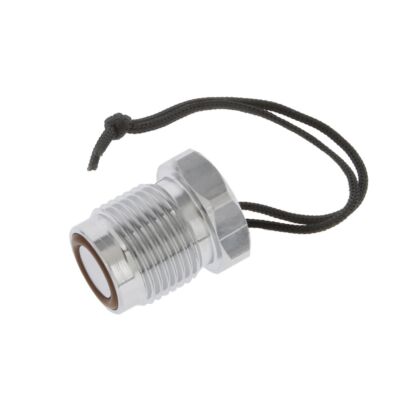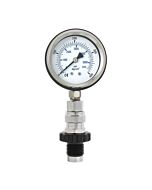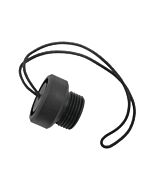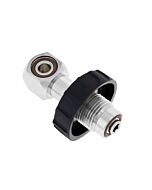DGX HP Sealing DIN Plug
- Eliminates accidental gas leaks from your valves
- A true HP O-ring seal for 200-Bar and 300-Bar valves
- Perfect to protect $$ Trimix fills
- Travel and move filled tanks with confidence
DGX HP Sealing DIN Plug
The HP Sealing DIN Plug provides a true high pressure O-ring seal in both 200-Bar and 300-Bar valves; it's primary purpose is to prevent gas loss from leaks caused by the valve being inadvertently opened. The typical use is to protect an expensive (or just plain important) gas fill from accidental loss while the cylinder is being handled or transported. Our design is chrome plated brass, exactly the same material as your valve and thus is NOT subject to galvanic corrosion and galling. We have seen that happen with other plugs made of a dissimilar metal; all that's needed is a little saltwater moisture and then the plug seizes in the valve.
The moment a DIN HP Plug is removed from the valve it seems to grow legs and walk away, so screw it into the first stage DIN cap from your regulator and secure it with the lanyard. If you discover you are unable to remove the plug by hand because it's being held in place by the pressure of the gas trying to escape then a dangerous condition exists, see the warning below for more information.
| Brand | DGX |
|---|---|
| SKU | DX-701301 |
| Weight | 0.120000 |
Customer Reviews
 WARNING
WARNING
We do NOT recommend the use of any type of HP sealing DIN Plug with oxygen rich gas mixtures, as impact or the friction of loosening the plug against high pressure oxygen could cause ignition, fire, and explosion leading to injury or death.
A dangerous condition exists if the plug has been pressurized by inadvertently opening the valve. No amount of force by hand will move it. First you MUST tightly close the valve, and only then you MUST loosen the plug with a wrench VERY SLOWLY and stand clear of the plug as you turn the plug in the valve. Make sure the plug is "aimed" at something able to withstand the force of ejection and no part of your body is in the path the plug might take if it is forcefully ejected. Back the plug out of the valve one full turn, but no more, this is enough to break the O-ring seal. Gas will gradually leak out around the threads until eventually the plug is loose enough to turn by hand, however even then we recommend continuing to use the wrench to turn the plug. If you do it slowly enough, you will hear a "hiss" and then a soft "pop" as the plug is ejected and falls to the floor.
If you find the plug and valve pressurized for no apparent reason and the valve is not found to be opened, it's very possible the valve has been leaking and the leak has been stopped by the plug. In this case, there is no quick way to remove the plug without extreme hazard because you are unable to determine the magnitude of the valve leak while the plug is in place. We recommend you take the cylinder to a cylinder hydrostatic testing facility for assistance removing the plug.
Damaged 300 bar DIN valve outlets
We occasionally hear from a customer that a new 300 bar DIN fitting on an adapter, gauge, fill whip or even a regulator is not compatible with some or all of the existing 300 bar DIN valves on their cylinders. Unfortunately the problem is more likely to be that the 300 bar DIN valve outlets have received an impact on the edge of the opening and are warped very slightly out of round. This causes a brand new fitting, perfectly within specification, to not be able to screw all the way in to the bottom of the warped outlet on the valve and fail to completely seat the sealing O-ring. However, it is not unusual for an existing regulator fitting or existing shop fill whip fitting to be able to seat because their threads are worn.
You should replace the valve, but sometimes the outlet is only very slightly out of round and might be made usable by a process known as "chasing and cleaning" the threads. You will need something to chase the threads and unless you are a machinist you are not likely to have the proper tools† handy. We suggest using a HP DIN Sealing Plug and a wrench, or a Yoke Insert and a hex key. Use the tools to force the fitting to screw tightly all the way in to the bottom of the 300 bar DIN outlet then back the fitting out completely and blow out the opening; repeat several times until the fitting easily screws in to the valve.
The risk to chasing and cleaning the threads is you damage the makeshift tool instead of correcting the valve outlet. It really only works if the outlet is very slightly out of round, so subtle that the warp is not readily apparent to the naked eye. If the valve has a noticeable ding at the edge such that it is clearly out of round, trying to chase and clean the threads won't work and you will have to replace the valve.
†The DIN SCUBA valve outlet is British Standard Pipe Parallel "G" Series (BSPP) 5/8-inch DIA X 14 TPI with 55 degree pitch Whitworth thread form. Very few dive shops have the relatively expensive tapping tool needed to re-thread a DIN outlet; best practice says that valves with damaged threads should replaced because re-threading might remove too much material and weaken the connection.





